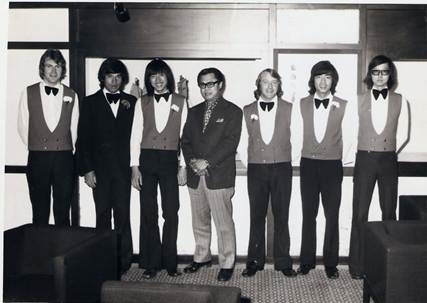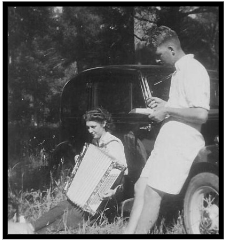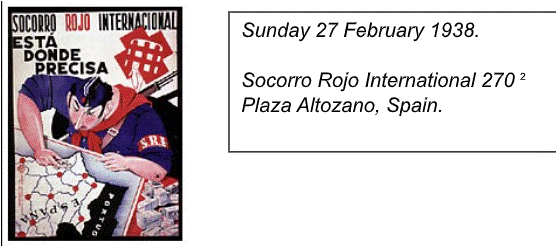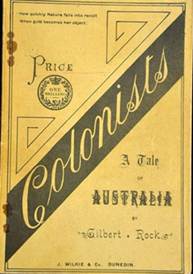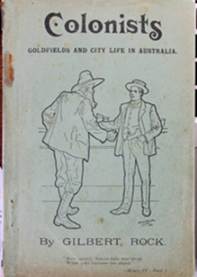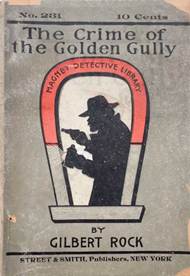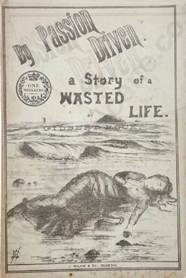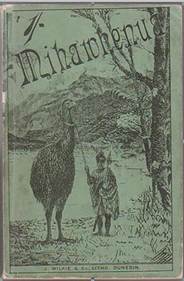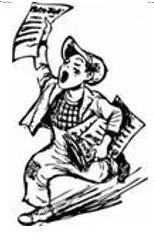
Part of the worldwide genealogy/family history community
ISSN 2253-4040
Quote: "There was a lady walking down the pavement and as we passed she stopped and she said: 'I know you, don't I?' ... I said: 'My name's Muldoon.'. She said: 'You're not related to that bastard in Parliament, are you?'. And on that salutary note Mr Speaker, I say goodbye". – You know who
Contents
Do you want to receive this newsletter every month?
Changing your Email, or Stopping Newsletters
Chinese Restaurants In
Auckland
More Famous New Zealanders You have Probably Never Heard Of
MACKY Joseph Cochrane
(1855-1915)
The Spanish Civil War – An Idealist’s War 1938
John Alexander Barr,
1855-1907
From our Libraries and
Museums
Hokianga Museum and Archives Centre.
How to research medieval
ancestors
23andMe fined £2.31 million
for ‘profoundly damaging’ data breach
How to find bankruptcy
records online
How to use passenger lists
for family tree research
Sheriff court paternity
records: How they can help you with Scottish family history
British Army records: Where
to find them online
What are the best Canadian
genealogy sites?
What Can a WWI NZ Service
Number Tell You? Quite a Lot.
To Unsubscribe,
Change your Email Address, or Manage your Personal Information
Editorial
 Hello
fellow hermits.
Hello
fellow hermits.
Greetings and welcome to another issue of the FamNet newsletter.
The Family History Expo is supposed to happen in early August in Auckland (There are others in other regions). I thought it was aimed at those who are newbies or relatively inexperienced at this hobby and would be a valuable recruitment exercise for the Society. I tried to get a look at the programme so that I could plan my attendance and to draw your attention to it. To be successful it needs to be advertised everywhere. This newsletter would have done it for free. BUT I cannot find a copy of the timetable anywhere – even the NZ Society of Genealogists website. Is this another proof of the “talents” of this organisation? I should point out that Auckland Library is not involved this year.
After knocking my head against the wall I shall say no more other than it should be a valuable aid to your research. You should attend. I will be there and, as always, will be available for a coffee (at your expense) and a pleasant exchange of advice, jokes, general banter etc.
Anyway, back to reality. Once again, we have an interesting newsletter. The articles are varied. The jokes are funny although they are not the main reason for reading the newsletter.
I hope this month’s issue occupies some of your time and you find something valuable.
Peter Nash
Do you want to receive this newsletter every month?
This newsletter is free. There are not many free newsletters of this length in New Zealand. I am biased but it should be an interesting read.
To subscribe is easy too. Go on - don't misspell it as I have, twice already. https://www.famnet.org.nz/
The front page is lovely, but click on [Newsletters]. A page opens showing you a list of all the past newsletters, you can click the link to read one that you’re interested in.
Like the front page, the newsletters page has a place where you can log on or register. It’s in the top right-hand corner. Put your email here and click [Continue]. If you aren’t already on our mailing list, there will be a message “Email not in database” and a button [New User] appears. Click this and follow the dialog to register. It’s free and easy. You should receive a copy every month until you unsubscribe.
Robert has assured me that he will not send begging letters to your email - apparently, he has enough money at the moment. You will not have to put in your credit card number. You will not be charged a subscription.
Tell other genealogists so they can enjoy the newsletters too.
Regards
Contributors
From the Developer
FamNet and FamilySearch
 Everybody except new readers will be
aware that the plan for ensuring that the data in the FamNet database survives
me is to give a copy to FamilySearch. I’m 79, and since I haven’t found a
way to guarantee personal immortality, I needed a plan B to ensure that you
don’t all lose your valuable family history. Documents have been signed giving
FamilySearch permission to do this, and, with emails to those with records
stored in the database, I have ensured that everybody with data has either
given permission for this, or have told me that they object. I removed
the data of those objecting from FamNet, believing that well before this we’d
be underway with this process, experimenting to find the best way to get all
our data (including scrapbook – pictures, documents, etc.) copied from FamNet
to FamilySearch. But there has been silence from FamilySearch, so I
emailed my contact. Had FamilySearch lost interest?
Everybody except new readers will be
aware that the plan for ensuring that the data in the FamNet database survives
me is to give a copy to FamilySearch. I’m 79, and since I haven’t found a
way to guarantee personal immortality, I needed a plan B to ensure that you
don’t all lose your valuable family history. Documents have been signed giving
FamilySearch permission to do this, and, with emails to those with records
stored in the database, I have ensured that everybody with data has either
given permission for this, or have told me that they object. I removed
the data of those objecting from FamNet, believing that well before this we’d
be underway with this process, experimenting to find the best way to get all
our data (including scrapbook – pictures, documents, etc.) copied from FamNet
to FamilySearch. But there has been silence from FamilySearch, so I
emailed my contact. Had FamilySearch lost interest?
The answer is “No”, they remain very interested in hosting our data. The issue is that it has taken longer than expected to get their new system, which they’re calling “Managed Trees” working. Who ever heard of an IT project running over time? Only everybody. So I still have no timetable for when we’ll start on the next phase, experimentally copying our data into their new system. But a reminder: if any of you have data in FamNet that you do NOT want to be copied to FamilySearch, let me know and I’ll note this, and make sure that it is omitted from any copy.
FamNet itself will continue for as long as Peter and I can manage it, but I’ve been unable to find anybody to continue it. I even approached the NZSG, but there was total silence there. Your data in FamilySearch will be managed by FamilySearch’s system, the web pages will look different and I’m not sure which features of FamNet will be replicated in the new system. On the positive side, I expect that there will be many new features that FamNet doesn’t have.
I will of course keep you all informed through this newsletter when we start working to achieve a copy to FamilySearch, and I learn about the capabilities of their Managed Tree system.
Changing your Email, or Stopping
Newsletters
If there is an issue with your getting the FamNet newsletter and you want me to do something about it, you MUST let me know your email. If you want me to change your email I need BOTH your old and new email. Here is a message that I received after I sent the June 2025 newsletter out: -

That’s ALL the information I get back from our mailing service (Amazonses). If you’d told me the email where you received the newsletter I could have turned off the newsletter. If you’d wanted me to change your email to another, I could have done this if you’d given me the old email as well as the new one. But if I don’t know your current email you’re just one of about 5000 possible emails in our newsletter database, and I can’t see the address to which the newsletter was sent.
The Nash Rambler
The
Waikino Tragedy 1923
 When
I was updating the burial records for the Hillsborough Cemetery I came across a
grave for a Thomas A O’Grady, a policeman, who died in
April 1941. Because I was giving guided tours of that cemetery, I researched
the facts about this policeman and found that he was associated with the
Waikino Tragedy in which two school children were shot and a number of other
children and teachers were wounded.
When
I was updating the burial records for the Hillsborough Cemetery I came across a
grave for a Thomas A O’Grady, a policeman, who died in
April 1941. Because I was giving guided tours of that cemetery, I researched
the facts about this policeman and found that he was associated with the
Waikino Tragedy in which two school children were shot and a number of other
children and teachers were wounded.
Where is Waikino?
Waikino is in the Karangahake Gorge which is between Paeroa and Waihi. When you are driving through that gorge you will come across an old country pub/hotel. If you turn onto the road next to that building and drive up the hill you will come to the little settlement of Waikino.
|
|
|
[1]Gold mining around Waikino has a history dating back to early colonisation of New Zealand. Waikino was the focal point of gold mining in the Waikato-Bay of Plenty district with the 1897 construction of the Victoria Battery on the edge of what was a busy town supporting the extensive local mining industry. Waikino's Victoria Battery processed ore from the large Martha Mine in Waihi. The Victoria Battery was then New Zealand's largest industrial complex. Besides processing ore, it supported carpenters' shops, a sawmill and a foundry. With 200 stamps, the battery was the largest quartz crushing plant for gold extraction in Australasia, and was capable of crushing over 812 tonnes of ore each day to the consistency of sand. The loud thumping sounds of crushing rock could be heard 10 kilometres away.
[2]The Waikino School was built on a steep slope, so that it was virtually two storeys at the back, and one at the front. It overlooked a large playground extending steeply down to a belt of trees at the bottom of the section. [3]It was on a hill about half a mile distant from the township and in an isolated position reached by a steep and winding path, a tortuous climb for little ones, especially in the winter months. Incidentally the school was burnt down some days after the tragedy. Apparently, there were four assistant lady teachers and some 150 pupils on the roll.
Who Was John Christopher Higgins?
John Christopher Higgins was an Irishman who had emigrated to New Zealand from Canada. According to newspaper reports he was middle aged, married man, and was described as a firewood dealer and settler at Waitawheta, a little settlement nearby. [4]According to the Waihi Daily Telegraph, residents of Waikino described Higgins as a somewhat morose man, with little to say, but none looked upon him as a dangerous man or one likely to commit a crime.
[5]There were a few theories about the motive for the shooting tragedy the main one being that the Truancy Officer had communicated with Mr Higgins and demanded that his son attend school. But there had been no such communication and there had been a prosecution a few years before the 1923 “incident” for this reason.
What happened
On 20 October 1923 at about 10 am, The Headmaster, Mr Reid, noticed Mr Higgins coming into the schoolhouse. Higgins told Mr Reid that he was going to shoot all the children attending the school. After failing to dissuade Higgins Mr Reid yelled to everybody there to run for their lives. Higgins shot Mr Reid in the mouth and the headmaster “played dead” on the floor.
Higgins then started firing on the fleeing pupils and teachers. He moved through the classrooms shooting at the pupils hiding under the desks. Two were fatally shot and another four wounded.. Everybody who managed to flee gathered down the steep grounds. Some pupils managed to get to the miners down the hill and called for the police. Higgins continued to try and shoot the escaped teachers and pupils from the schoolhouse. After finding all pupils had gone Higgins prepared to set the building alight and placed Mr Reid on a pile of paper.

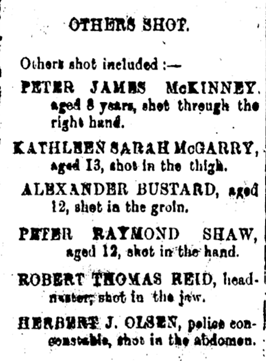
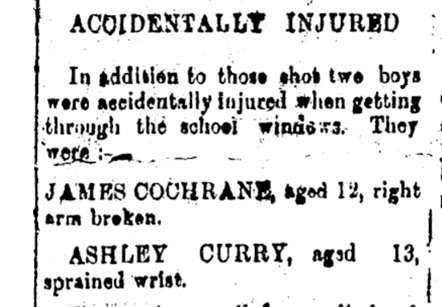
 The Police were called the scene and
Senior Sergeant O’Grady, Constables Olsen and Whiting
arrived. Two doctors also arrived. The police tried to enter the building but
were met by Higgins and thus retreated. Sergeant O’Grady fired some shots
through the window above the door but “missed”.
The Police were called the scene and
Senior Sergeant O’Grady, Constables Olsen and Whiting
arrived. Two doctors also arrived. The police tried to enter the building but
were met by Higgins and thus retreated. Sergeant O’Grady fired some shots
through the window above the door but “missed”.
The police gave authority to armed residents and miners to fire upon Higgins but they were below the school and the angle of firing was impossible to hit Higgins. Apparently Higgins brought primed gelignite with him and luckily no bullets hit it.
Sergeant O’Grady and Constable Olsen managed to get into the schoolhouse. They called upon Higgins to surrender. Constable Olsen tried to get a better viewpoint but exposed himself to Higgins who shot him in the stomach. Further shots were exchanged. O’Grady and Constable Trask decided to charge at Higgins and overpower him. They succeeded and Higgins offered very little resistance.
Higgins was arrested and on 15 December 1923 he was charged with murder. His defence was insanity. [6]For a very full report on the Supreme Court case I suggest that the book by Sir Vincent Meredith be consulted. Higgins was found guilty and sentenced to death, but this was commuted to life imprisonment. After serving some years of the sentence he was released and it is understood that he returned to Canada.
[1] Wikipedia
[2] “A Long Brief – Recollections of a Crown Solicitor” by Sir Vincent Meredith, Published by Collins, 1966
[3] Waihi Daily Telegraph 8 December 1923
[4] Waihi Daily Telegraph, 20 October 1923
[5] Waihi Daily Telegraph, 23 October 1923
[6] “A Long Brief – Recollections of a Crown Solicitor” by Sir Vincent Meredith. Published by Collins 1966
Death
Notice
To the right is a death notice in the NZ Herald. I was very amused by the wording, particularly the “planting” into the cemetery.
Chinese Corner
Chinese Restaurants In
Auckland
The Orient THE ORIENT Restaurant in the Strand Arcade was the first Authentic Licensed Chinese Restaurant to be opened in Auckland by restauranteur Ray 'King Ming' Gin later sold in 1978 and renamed ' New Orient ' The luncheon-service is as fast as one wishes at the Orient Chinese Restaurant in the Strand Arcade, Auckland… One serves one-self. Ray Ming, owner of the Orient has begun buffet. Chinese luncheons and they are good news for the busy person. Here he serves me from one of the many dishes which feature pork, beef, ham, chicken, cuttlefish, eggs, many different vegetables, rice and vermeceli. Chinese tea and coffee are freely available and white wine may be bought by the glass. Luncheon is $5.
New Orient 新東方酒家 New Orient in the
Strand Arcade was Auckland's
oldest Chinese restaurant*, and closed in 2010 after nearly 40 years in
business. Originally "The Orient", it was sold in
1978 and renamed "New Orient." Retired
seaman Ricky Wallace, 75, remembers the New Orient as a fixture in the
Auckland dining scene. It was one of only about three Chinese restaurants in
Auckland in the 1970s. The New Orient, upstairs above an arcade in Elliott St, offered Chinese food that was beautifully presented, albeit the cuisine that Kiwis had come to expect in such restaurants; sweet and sour dishes, lemon chicken, fried garnished rice, whole steamed fish and much, much more. |
|||||||||||||||
More Famous New Zealanders You have Probably Never Heard Of
MACKY
Joseph Cochrane (1855-1915)
 Joseph
Cochrane MACKY was born on the 06 March 1855 in Auckland, the son of Thomas
Lindsay and Catherine Macky née COCHRANE. Thomas had arrived in Auckland from
Londonderry in 1849 on board the Duke of Portland to meet up with his
brother James who was already in business as a general merchant.
Joseph
Cochrane MACKY was born on the 06 March 1855 in Auckland, the son of Thomas
Lindsay and Catherine Macky née COCHRANE. Thomas had arrived in Auckland from
Londonderry in 1849 on board the Duke of Portland to meet up with his
brother James who was already in business as a general merchant.
Catherine (Kitty) Cochrane followed Thomas to Auckland on board the Catherine Stewart Forbes and the couple married on the 23 March 1852 at St Andrews' Presbyterian Church. The family lived in a brick house on Hobson Street, opposite St Matthew's Church before moving to Hepburn Street, Freemans Bay and then to Devonport on the North Shore.
Joseph was educated in Auckland and worked in the soft goods trade there. In September 1878 Joseph married Isabella Campbell KENNEDY in Auckland. The couple went on to have three sons and a daughter. Unfortunately, Isabella died just two weeks after the birth of their youngest son John (Jack). She was buried in the Symonds Street cemetery. In October 1888, Joseph married Janette Mary Isabell BIRRELL in Melbourne. The couple also had three sons and a daughter, all born in New Zealand.
In 1882 Joseph formed Macky, Logan, Steen, and Co, clothier and haberdashery. The business eventually grew to a three-storey warehouse with frontages to Victoria, Darby, and Elliott Streets and Theatre Lane.[7] Said to have the largest floor space in the country the warehouse departments stocked Manchester (calicoes, linens, shirting, cotton flannel, blankets), clothing (oilskins, mackintoshes), woollen (for heavy and medium tailoring), men’s mercery (shirts, collars, portmanteaux, bags, hats, ties, scarves), hosiery (hose of cotton, merino, wool and silk, as well as gloves of silk, taffeta and kid), dress (silks, velvets, velveteens, plushes, ribbons and laces), hat (millinery, flowers, feathers, trimmed hats and men’s straws) and underclothing. The warehouse employed over 50 people with much of the merchandise sourced from New Zealand companies. This building was gutted by fire in November 1911; the loss of building and stock estimated at £150,000.
The firm also operated a sewing factory in Victoria Street and employed over 150 people manufacturing ‘Cambridge’ collars, white and coloured shirts and other clothing. Warehouses were also opened in Wellington, Napier, Wanganui, New Plymouth and Dunedin. In 1908 the firm became known as Macky, Logan, Caldwell & Co.
In 1892, Joseph became a councillor for the Borough of Devonport, and Mayor in 1896, being re-elected in 1897/98 and finally retiring at the end of 1900 after four terms in office. In 1898, he became the Devonport representative on the Auckland Harbour Board. Joseph was also a trustee and member of the Royal New Zealand Yacht Squadron and was the vice-president of the National Defence League when war broke out in 1914.
On the 26 March 1915, Joseph and Mary left Auckland on a visit to England via New York to visit his daughter Isabella Wilson JELLIE and her Unitarian Church minister husband William, who were living in Southport, Lancashire. They were possibly on board the RMS Niagara.
On the 29 April 1915, Joseph wrote to his son Tom in Auckland to say that they were on board the Cunard steamship Lusitania in New York, bound for Liverpool. Joseph noted that he had managed to get a first-class cabin all to themselves at second class rates, saving the extra £35 for 5 ½ days trip.[8]
At ten past two, on Friday 07 May 1915, eleven miles (18 km) off the Old Head of Kinsale, Ireland, the German submarine U-20 fired a single torpedo at the Lusitania, triggering an explosion which sunk the ship within 18 minutes. Only six of several dozen lifeboats and rafts were successfully lowered, and of 1,960 people on board, only 767 survived. Those killed included 128 US citizens, and this helped turned American opinion against Germany. However, the United States did not declare war with Germany until April 1917.
Joseph and Mary are said to have met their ends with calm heroism. When a seat in a lifeboat was offered to Mary, she declined and insisted that a younger woman passenger take it. Mary was quoted as saying, "I am getting old and would rather stay with my husband. You are younger and have life before you." Joseph and Mary were last seen standing on deck together, calmly awaiting the end. On arriving in London, the lady to whom Mrs Macky surrendered her seat advertised to obtain the address of Jack Macky[9] and told him the story of his parents’ death.
A well-attended public memorial service was held in the
Auckland Town Hall on 20 May 1915. Businesses were closed for two hours to
enable staff to attend. Anti German feeling in New Zealand was also high, and
the Observer of the 22 May 1915 reported “AUCKLANDERS who grieve for Mr and Mrs
J. C. Macky, who were murdered by the Germans with many hundreds of other
Lusitania passengers, thus have the dastardly conduct of the world’s greatest
assassins brought home to them. They know that, for no assignable reason, a
highly honoured Auckland lady and gentleman were murdered, and that their
feelings are shared by relatives, friends and countrymen of other people
equally honoured and respected. Every Aucklander should "Remember the
Lusitania," and every Aucklander will be assisted by remembering Mr J. C.
Macky. They retaliate by every man possible to avenge the murders, by hating
everything German, by ceasing to be hospitable to Huns, and by feeling as
bitter to the beasts as the beasts are to us. We cannot restore Mr and Mrs
Macky to Auckland, but we can help to avenge 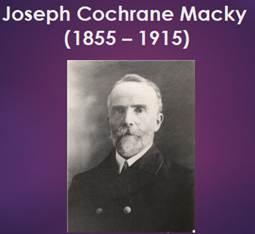 their deaths.”
their deaths.”
In December bequests from Joseph’s will were reported in newspapers - Employees of the firm £20,000; Unitarian Church £1000; Door of Hope Rescue Home £1000; Jubilee Institute for the Blind £1000; Plunket Nurse Society £500; St. James’s Presbyterian Church £500; Kindergarten Association £500; Leslie Presbyterian Orphanage, £500. His total estate was valued at £104,017 ($19m in 2025).
In March 1916 steps were taken to establish a scholarship memorial to Joseph Macky, and a tablet to the memory of the couple was unveiled in the Unitarian Church, Ponsonby.[10] In 1917 a portrait of Joseph was hung in the Devonport Council Chambers and in 1920, Cheltenham Terrace, Devonport was renamed Macky Avenue.
Other New Zealanders on board the Lusitania were: Nurse Eleanor CHARLES, James Andrew GARDNER, (Mrs) Annie Gardner (née GRAY), Eric Gardner 16, William Gerard “Willie” Gardner 11, (Mrs) Nina WICKHAM 50. Mrs Wickham was returning to England after visiting her sons in New Zealand. She was to sell up her belongings to return to New Zealand. The Gardner’s were originally from Dunedin but had been living in Toronto. Eric and William survived the sinking, but Eric was killed at Passchendaele in October 1917 with the NZEF. Nurse Charles was born in Central Otago, and trained at Auckland, then in Vancouver. She was on her way to London to offer her services for war service.
1 New Zealand Herald, Volume XXXVII, Issue 11487, 26 September 1900, Page 2 (Supplement)
2 Archives New Zealand Probate MACKY Joseph Cochrane - Devonport – Warehouseman Code R21449899 Year 1915
3 Jack had sailed a week earlier from New York. He was to sign up with an Imperial Regiment.
4 https://www.findagrave.com/memorial/216241206/joseph-cochrane-macky
Other:
The Cyclopedia of New Zealand [Auckland Provincial District]
Lusitania Passenger List https://www.rmslusitania.info/lusitania-passenger-list/
The Macky Family in New Zealand https://macky.net/origin.html
William Jellie, unitarian, scholar and educator https://mro.massey.ac.nz/server/api/core/bitstreams/36086441-e9c0-48b9-afe0-cbf8e07ce986/content
[7] New Zealand Herald, Volume XXXVII,
Issue 11487, 26 September 1900, Page 2 (Supplement)
[8] Archives New Zealand Probate MACKY
Joseph Cochrane - Devonport – Warehouseman Code R21449899 Year 1915
[9] Jack had sailed a week earlier from New
York. He was to sign up with an Imperial Regiment.
[10]
https://www.findagrave.com/memorial/216241206/joseph-cochrane-macky
Ken
Morris
Ken is visiting New Zealand at the moment and is so deep in remembering the past that he has no time to contribute this month.
Robina Trenbath
The Spanish Civil War – An Idealist’s War 1938
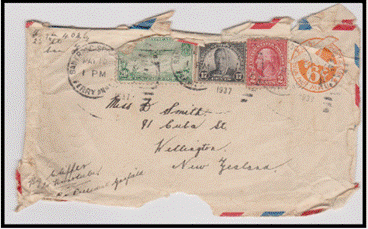 1
1
New York City
January 31st 1938
Dear Dorothy
I know you will be surprised and perhaps think I am foolish, mad, stupid and lots of other names. Well, I am going to Spain to fight for the Loyalists seeing you do not understand what everything is all about. There is nothing I can do to improve your
knowledge. As it would take pages and pages and when I finished up, I probably would never have done any good and I think that covers the subject.
Only to say I am not going as a soldier of fortune or advocate as, in the first place I have know time for soldiers of fortune as they are phoneys and second, I think, I have had all the adventure any man wants. I know I am sacrificing a lot.
So, if I should never see you again, I leave tomorrow for France then Spain. Before I leave, I mean close this letter I want you to know I have always been a Communist. The REDS as the Capitalists call them. I was going to tell you a long time ago, but I
thought it know use. We have a special invitation from the Russian Govt. to tour that country and then to go school for twelve months. That is after the war and then I’ll return to New Zealand and become active in the Labour movement.
Well goodbye Dot and lots of luck in your piano accordion and beauty lessons. Please remember me to your family and tell them I still consider them my friends – good old Bert and many happy returns on your 21 st birthday. If you care to write my address is still the same,
they will send it on.
Goodbye.
Your friend Bill Madigan
|
(Photo 1936: Dorothea & Bill). |
|
Dear Dorothy
Well, the last time I wrote to you was in New York and I tried to explain why I came to Spain. My brother does not know I am over here. The reason I mention that is I don’t want you to mention it, even though you do not know him very well.
I always live in hopes of coming through this and if I do, well, I have done my share. Well, not all of it but a little. I am sorry I am not able to say what part of Spain I am in but this address will always get me.
At present I am sitting down by a stream and the Spanish women are doing the washing just like the French do it. In fact, I have one woman doing mine. She’s a swell lady and she has a little girl about Rewa’s age. Their sons are up at the front.
All the boys and girls packed around me now and trying to figure out what I am writing. One little fellow says: “ Lettres Englishes”. Meaning I am writing a letter.
I guess I have only been in Spain a week, so I am just learning, but Dot, these children here lost most – Mother and Dad. It’s for instance, say, Rewa losses her Mother and Father in a bombing raid in Wellington by German and Italian planes.
Just as has happened in all the big towns of Spain – Madrid, Barcelona and scores of other places. So if I should never come back, you know I understood and sacrificed. All I can say now is remember me to your family.
Goodbye and good luck. Bill.
Salud Comarade No Pasaran = which means “They shall not pass”. By that the Spanish people mean the fascists.
Wellingtonian William Madigan, described as a ‘larrikin, seaman, hobo and adventurer’. He arrived in Spain from the U.S.A. earlier that year and joined the Abraham Lincoln Battalion. 3. Like many of the international volunteers, he adopted an assumed name – Martinez – as foreign nationals had been warned they would be shot if captured.
The Abraham Lincoln Battalion was a unit of approximately 2,800 American volunteers who fought on the Republican side during the Spanish Civil War (1936-1939). It was part of the larger XVth International Brigade, which also included battalions from other countries. The Lincoln Battalion was organized by the Communist International which included individuals from various backgrounds, including students, workers and professionals. 4.
William Thomas Madigan (aka ‘Martinez’) was born on 24 July 1916 @ Wellington, the son of Kathleen Mary Madigan. For many years he was a family friend of the Crampton-Smith family. Over two years (1936-1938) he wrote 4 letters to our mother
(Dorothea Crampton-Smith) and sent a 7-page pictorial pamphlet of the ‘XV International Brigade Volunteers in Training’.
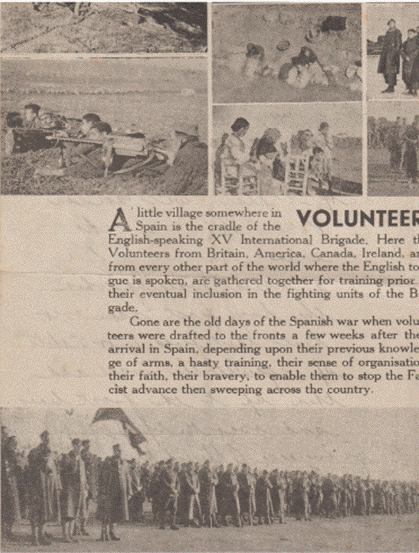 The New Zealand government of the
day sat on the fence in this lead-up to W.W.11. However, it did not stop a
cohort of about 20 Kiwi volunteers (communists, trade unionists and
humanitarians) leaving and along with 60,000 anti-fascists from all
The New Zealand government of the
day sat on the fence in this lead-up to W.W.11. However, it did not stop a
cohort of about 20 Kiwi volunteers (communists, trade unionists and
humanitarians) leaving and along with 60,000 anti-fascists from all
over the world, to join the left-wing government (Republican forces) fighting against Francisco Franco’s Nationalists - …the Vatican recognized Franco’s nationalist regime in 1937. The fascist arms of Italy and Nazi Germany had reached out and
taken the Spanish despots, into their embrace.
N.B. The deaths of at least six New Zealanders in Spain went largely unnoticed at home. Bill Madigan, it is assumed, was killed in the Battle of Ebro River (July-November 1938). He is recorded on the Auckland Museum Online Cenotaph.
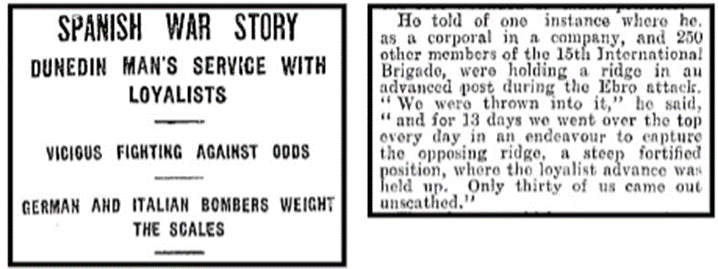
5
The only organized contingent from New Zealand to the Spanish Civil War consisted of three nurses recruited by the New Zealand Spanish Medical Aid Committee. Rene Shadbolt, Isobel Dodds and Millicent Sharples left New Zealand on 18 May 1937 and arrived in Spain on 18 May 1937. Other New Zealand nurses made it to Spain independently.
References:
1. William Madigan: Envelope for Letter No.1 of 4* to Miss D. Smith. Post marked: San Francisco, 1 p.m. May 10, 1937. By Clipper to Honolulu per President Garfield. N.B. *I have taken excerpts from two of 4 letters.
2. Socorro Rojo International. library.ucsd.edu N.B. The International Red Aid was affiliated with the Comintern in Moscow and it made its first appearance in Spain in 1934 in connection with the aftermath of the workers’ rebellions of October 1934.
3. Abraham Lincoln Battalion: www.britannica.com/ The modern world.
4. The Spanish Civil War/ Pages 1-7/ Page 4: NZ Combatants in Spain. nzhistory.govt.nz
5. Spanish Civil War Story: in Evening Star, Issue 23213, 11 March 1939. P. 20. paperspast.natlib.govt.nz
Dennis Wright
John
Wright / John O’Brien
My grandfather John Wright was born on 27 May 1863 in Kaeo, Northland, the second child of Charles Wright and Allacia McAvoy. Records show Charles suffered an accident in the bush dying on 8 April 1874, the day after he signed a will with his mark, leaving his all to Alice McAvoy with whom he had been living, (they were not married, but had had six children together).
Of course, in 1874, Death Certificates did not require the Place of Birth or the Parents names of the Deceased, but shows he was 41 when he died, that is born 1832-3, but where?
I was taken to see the house situated alongside the Kaeo Primary School in 1953 as a child of 10 and visited again in 2017 by which time it was quite derelict.
Trying to go back to find earlier ancestors, I searched Newspapers, shipping records, records of Early New Zealand Settlers, census records for all Wrights prior to 1860. I was able to rule all Wright men and families out except a John Wright, Blacksmith shown to be at Otarahiko on the Hokianga in the Busby Census of 1838 showing John Wright married with 2 children. Charles Wright b 1832-33 was likely one of these children. Otarahiko is about 70km from Kaeo in Northland.
There are
references to this John Wright in Edward Markhams’ “New Zealand or
Recollections of it” 1834, and Alfred Yarbourough’s Memoirs of 1872 and
1875. The land at Otarahiko 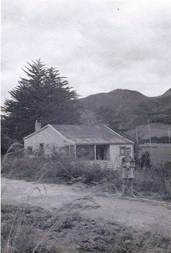 consisting of 10 acres 1 rood was advertised for sale on 28 May 1877,
but when and how did he arrive in New Zealand? I cannot find a death
record for him.
consisting of 10 acres 1 rood was advertised for sale on 28 May 1877,
but when and how did he arrive in New Zealand? I cannot find a death
record for him.
If John Wright was on the Hokianga in 1834 and had two children in 1838 and four by 1846(Cleland census), he was likely born after 1800 and before 1815.
In 2005 I took my first DNA test, hoping to find a matching Wright in England to continue my search there. Imagine my surprise to find my paternal line was from Ireland, a member of the Dál gCais clan of which the principal surname is O’Brien!
See my
paper, A Set of Distinctive Markers Defines a Y-STR Signature for Gaelic
Dalcassian Families - Wright 2009 https://jogg.info/wp-content/uploads/2021/09/51.002.pdf
Checking the “Early New Zealand Settlers 1769-1839” I found a J O’Brien who arrived from Sydney prior to 1839 and bought land from the natives on the Hokianga. There is no further record of this J O’Brien.
Many ex-convicts came to New Zealand in the 1830s and often changed their names so a search of convicts to NSW revealed a John O’Brien, b 1809 in Waterford, was convicted in Clare in 1825, being sent to Sydney to serve seven years on the “Countess of Harcourt” in 1827. He was employed on Iron Gangs so learning blacksmithing skills and received his Certificate of Freedom on 15 August 1832.
Was this my ancestor, arriving on the Hokianga and purchasing land from the Māori, changing his name from John O’Brien to John Wright and setting up as a blacksmith to start a new life?
Information is scarce to prove or disprove this theory but at least my DNA shows I come from Ireland. Perhaps that is all I need to know.
Rowan
Gibbs
John
Alexander Barr, 1855-1907
In May 1888 a little known Dunedin author, “Gilbert Rock”, petitioned Parliament to introduce “a protective tariff on all imported literature”, stating “I am prepared to supply the colonial market with literature if inducement offers”.[1] The Public Petitions Committee made no recommendation, but the widespread media attention (newspapers called the proposal everything from “hilarious” to “impudent”) created splendid publicity for Mr Rock’s first novel, Colonists, published in June. It was soon revealed that the name was a pseudonym: “the author is believed to be Mr J.A. Barr, a solicitor”[2], who had already published a few stories and poems in local newspapers.
Colonists, a crime story set on the Australian goldfields, was the first of three paperback thrillers (“shilling shockers”, as they were called) published that year in Dunedin by the firm J. Wilkie & Co. The book sold well (especially in Australia) and by September had sold 8,000 copies, with an edition in England at the end of the year, followed by Canada and two in America (possibly piracies), these all under the more dramatic title The Crime of the Golden Gully.
A second novel by “Gilbert Rock” followed in September, By Passion Driven, a tangled tale of murder, forgery, and suicide, and then in October Wilkie published a rather imaginative adventure story, not under the name “Gilbert Rock” and not confirmed as by the same author until many years later. The title says it all:
Mihawhenua: The Adventures of a Party of Tourists amongst a Tribe of Maoris discovered in Western Otago, New Zealand. Recorded by R.W. Brock, M.A., LLB. Edited by R.H. Chapman. Being a Manuscript addressed to the editor found attached to a Maori kite on Mount Alta, near Lake Wanaka, and forwarded to him by the finder. The names Brock and Chapman were both fictitious.
There were several BARR families in 19th century Otago, and several John Barrs, but only one John A. Barr, and only he was a lawyer. John Alexander Barr was born in Dunedin on August 27th 1855, and baptised in First Church on September 30th, the eldest of six sons and six daughters born to William Barr and his wife Marjory, née SPEID; William’s parents were John Barr, a Paisley weaver, and Elizabeth, née STEWART, who arrived on the Philip Laing in 1848.[3] Young John studied law at Otago University, was articled to Sievwright and Stout, and was admitted as a barrister and solicitor in 1878. He first joined the partnership of Duncan & MacGregor, but was soon practising on his own. He is found as a defence lawyer in court but then increasingly involved in promoting company shares and real estate.
In 1880 in the Dunedin Registry Office he married Esther Ann DAVIES, born in Hobart on June 13th 1859, third daughter of Alexander Davies and his wife Sarah Alicia, née HYAMS, who settled in Dunedin in 1863 [4]. John and Esther were to have three daughters, Irene Rose, May Esther, and Myra Beatrice, in 1881, 1882, and 1884.
Over the next few years we see John doing some amateur acting and Esther running the Jewish bazaar. John was nominated as a candidate for Roslyn in 1881 (“a Greyite”), though he withdrew; he was briefly on the City Council in 1885. The 1882 Return of Freeholders shows him owning 14 acres in Taieri County worth £1150; property in Dunedin worth £3250; and property in South Dunedin worth £125, a total of £4525. The family lived in a large house in London Street, moving to Belleknowes in 1887. October 1889 saw a lavish joint wedding for two of Esther’s sisters by Rabbi Lichtenstein, which was written up in the newspapers (...Mrs Barr wore “a costume of crushed raspberry colour trimmed with lovely flowered broche, with French floral bonnet veiled with silk gauze...”; Irene, age 7, was bridesmaid).
A month later it all fell apart. Dunedin was shocked to learn that John Barr had disappeared, apparently with his clients’ funds. His affairs were said to be “very much involved”; he had gone to Christchurch “ostensibly to consult a relative by marriage there, with a view to putting matters straight”[5], but his whereabouts were now unknown. He was declared bankrupt on November 7th and a creditors’ meeting set for November 12th. This showed liabilities of about £10,000 and assets of about £14,000 but mired in mortgages and second mortgages. In a letter he wrote to a creditor on October 30th Barr said: “1 have cleared out so that any one creditor cannot take everything, and when I’m away all may combine and perhaps realise my estate to sufficient advantage to pay everybody. If this is not done I shall not rest till I have made good the deficiency, but I can do nothing by remaining and facing the matter out, as several creditors have determined to press me to the bitter end, and I am only able to get away now without more than enough to keep me from starvation for a month or so. You see I am not taking any of the money with me, and have to leave my poor wife and children to the bounty of friends until I can do something for them. You can rest assured I shall not leave anything undone to get the money you may lose paid back. Yours in contrition, John A. Barr.”
In August a “first and final dividend” was declared — 4d. in the £. Esther was allowed furniture to the value of £100, and under the Married Women’s Property Act which had come into force on January 1st 1885 (supported by Sir Robert Stout who was now chairing the creditors’ meeting) she may have been able to keep property she owned before the marriage. Their house was auctioned in September, and in the 1891 Stones Directory “Mrs John A Barr” is living in George Street; their daughters were ten, nine, and five.
It was speculated Barr had fled to Rio or had “done the Pacific Slope” (headed to San Francisco), but nothing was heard of him until 1892 when the Evening Star reported he “has taken up his residence in Kensington”, but “that gentleman, like ‘Brer Rabbit,’ seems to be ‘lying low’...”: exact address unknown. In fact in the 1891 U.K. census he is already living in London, in Streatham, together with Esther and all three daughters. In 1894 the Evening Star printed a note from its London correspondent saying that on August 17th he called on Sir George Grey and found him and his secretary trying to decipher a signature on a letter asking Grey for works on Maori legends which could be used for operas or dramas. The writer has “lately converted a legend of old Mexico into the libretto of an opera”, but “my only previous work on the Maori subject” was Mihawhenua, which he says sold 5,000 copies, adding “I sent you a copy when it first came out”. The letter had an address, 85 London Wall, E.C. (probably not his residential address), but as the writer’s name could not be read he was not identified as the sought after Barr. (Grey’s secretary cut out the signature and pasted it on the letter in reply with the address). [6]
The anecdote was reprinted in several New Zealand papers but no one, it seems, made the connexion with Barr. A 1900 London directory lists him in Addison Gardens, in Kensington, and in the 1901 census he is living at 64 Lansdowne Rd, Kensington (“Retired Solicitor Barrister”), together with Esther and daughters May (no profession given) and Myra (a “clerk”). John died there on July 21st 1907 (“Reynolds disease and pulmonary tb”) and Esther on October 7th 1910 (recorded as Esther Davies Barr); they are buried together in Kensal Green Cemetery, Kensington.
John’s indiscretions saw him largely written out of Otago and literary history. He has a very discreet entry in the 1905 Otago volume of the Cyclopedia of New Zealand under “Ex-councillors”: “Mr. John Alexander Barr was elected to the City Council for High Ward in 1885, but retired on the 10th of September of the same year. Mr. Barr was articled to Messrs Sievwright and Stout, and afterwards practised as a lawyer. He also took up literary work, but afterwards left the colony for London”.
Irene worked as a waitress in London and in 1909 opened ‘The Matinee Tearooms’ in Regent St. In the 1911 census she and Myra are living at 30 West Cromwell Road in Kensington, Irene a “restaurant waitress”, Myra a “private secretary”. Irene married Herbert L. BENJAMIN in London in 1915 and had a son and a daughter; she died there in 1951. Myra married Ernest HAINS in London in 1917 and had a son; she died in South Africa in 1923. May served as a staff nurse in Queen Alexandra’s Imperial Military Nursing Service Reserve in World War I, and it seems to be her sailing in 1919 from London to Portugal, which is listed as her intended place of residence; in the 1939 Register she is living in Margate in Kent (single, “hospital nurse, retired”) with her sister Irene (now widowed); she died there in 1956. [7]
[1] The petition was introduced by the Member for Dunstan, Vincent Pyke, who had himself published several novels locally.
[2] From the ‘Dunedin Gossip’ column in Cromwell Argus 5 June 1888; and soon after in another provincial paper, Mt Ida Chronicle 21 June 1888: “the talented author is generally known to be Mr J.A. Barr, solicitor, of this city”.
[3] John Barr senior’s house was in the “Little Paisley” area which later became the Southern Cemetery and when William died (in 1887 of apoplexy while driving to Mosgiel) he was buried virtually in the spot (S08.26) where his father’s house once stood.
[4] Alexander, born in Poland, ran the ‘Ballaarat [sic] Pawn Office’ in Princes Street until 1872, the year before his death.
[5] This was lawyer (later Supreme Court Judge) Thomas Walter STRINGER, married to Esther’s sister Ada.
[6] Barr’s 1894 letter is in Auckland Libraries Heritage Collections, Grey New Zealand Letters (GLNZ 5.1); also an 1894 letter from Barr to Grey concerning Grey’s 1846 dismissal of George Clarke. I am very grateful to Kirsty Webb for her help with this.
[7] The daughters were, of course, Jewish, since their mother was Jewish. A fascinating historical account of this Rabbinical matrilinear definition of Jewishness can be read in Donald Akenson’s book, Some Family, pp.158ff.
Mihawhenua online https://books.google.co.nz/books/about/Mihawhenua.html?id=xY8tAQAAMAAJ
Colonists online http://www.apfa.esrc.unimelb.edu.au/objects/images/image_viewer_paged.htm?colo,81,1,S
|
|
|
|
|
|
|
|
His undecipherable signature: Jn. A. Barr |
|
||||
An
Invitation to Contribute:
I have a number of people that contribute occasional articles. These appear irregularly if and when the authors send them to me. I use them to bulk up each month's newsletter. The more we have the more "rests "I can give my much-appreciated regular columnists.
This is a way that a person can get some of their writing published. Of course, we are all writing up our research results, aren't we? I have always said that every genealogist is an expert in some small piece of history, resources or research methods.
We circulate this newsletter to about 7,000 subscribers worldwide but is read by many more as it is passed on to other readers and LDS research centres. Every month I get feedback on my poor attempts at writing and I have now made many "new friends", albeit digital ones, I have even had some very helpful assistance in my research.
Why don't you contribute an article?
My basic requirements:
1) The column must be in English
2) The column should be no longer than about 1,200 words
3) The article should be emailed to me in a Word document format
4) The subject should be genealogical or historical in nature
Do not be afraid about your "perceived" bad English. The article will be edited, in a friendly manner, by me and then Robert. Then all columnists and a few valuable proof-readers get to read the newsletter before it is emailed out. You’ll be paid $0 for your article, which is on the same scale that Robert and I pay ourselves for editing and publishing the newsletter.
From our
Libraries and Museums
We are offering a forum to our libraries and museums to publicise their events, and to contribute articles to this newsletter that may be of interest to our readers. Auckland Libraries makes good use of this free service, let’s see if other libraries and museums take up this offer.
For readers of this newsletter: please bring this to the attention of your local libraries etc, and encourage them to participate.
Auckland Council Libraries
Did you miss one of our HeritageTalks, or would you like to listen to it again?
Enjoy our podcasts - recorded events and presentations
https://soundcloud.com/auckland-libraries
And see more on our YouTube channel
https://www.youtube.com/user/aucklandlibraries
Nga mihi | Kind regards
SEONAID
Seonaid (Shona) Harvey RLIANZA | Family History Librarian
Central Auckland Research Centre, Central City Library
Heritage and Research
Auckland Libraries - Nga Whare Matauranga o Tamaki Makarau
Ph 09 890 2411| Extn (46) 2411 | Fax 09 307 7741
Auckland Libraries, Level 2, Central City Library, 44 - 46 Lorne Street, Auckland
Visit our website: www.aucklandlibraries.govt.nz
@Kintalk on Twitter / Auckland Research Centre on Facebook
Hokianga Museum and
Archives Centre.
Hokianga Museum is home to objects and records from Hokianga, including written and photographic histories from many of the families who have lived here, history of the local communities, schools and the natural geography of the area.
There are also displays featuring Mangungu Treaty signing, 1893 Suffrage featuring Hokianga women who voted that year, The Dog Tax Rebellion, the 1918 Influenza pandemic, the timber and dairying industries, the 28th Maori Battalion A Company and accounts of shipwrecks, including the SS Ventnor. The Museum also houses Russell Clark’s original statue of Opo the Dolphin.
14 Waianga Place, Omapere, Hokianga
Open Monday, Wednesday & Saturday 10.00 -2.00pm.
09 4058498
From the Editor
This is a museum and Research Centre I am closely associated with. I have donated photographs, books, articles and historical items to this organisation. They do a brilliant job and, if you are in the area, well worth a visit. It is staffed by many volunteers and if you are brimming with spare cash they are a worthy organisation for a donation.
Group
News
News and Views
|
|
|
|
From the Editor: Because of space restrictions and copyright issues I cannot put the complete articles in this newsletter so here are some URLs that are worth looking at. Just click the heading.
How to research medieval ancestors
23andMe fined £2.31 million for ‘profoundly
damaging’ data breach
The history of exercise
How to find bankruptcy records online
How to use passenger lists for family tree
research
Sheriff court paternity records: How they
can help you with Scottish family history
British Army records: Where to find them
online
What are the best Canadian genealogy sites?
What Can
a WWI NZ Service Number Tell You? Quite a Lot.
If you’ve ever seen a WWI New Zealand service number like 6/1532 and wondered what it means — you’re not alone. Those small digits tell a BIG story.
![]() Early
in the war, New Zealand used a unique numbering system for the NZEF. Soldiers
were assigned numbers with a unit prefix, like this:
Early
in the war, New Zealand used a unique numbering system for the NZEF. Soldiers
were assigned numbers with a unit prefix, like this:
[Unit Number]/[Soldier’s Number]
For example, 6/1532 = 1532nd soldier in the Canterbury Infantry Regiment.
Those with a slash ( / ) usually enlisted early and many served at Gallipoli.
Here’s the full list of WWI unit number prefixes used before April 1, 1916:
1/ Samoan Advance Force
2/ Royal New Zealand Artillery
3/ New Zealand Medical Corps
4/ New Zealand Engineers
5/ New Zealand Army Service Corps
6/ Canterbury Infantry Regiment
7/ Canterbury Mounted Rifles
8/ Otago Infantry Regiment
9/ Otago Mounted Rifles
10/ Wellington Infantry Regiment
11/ Wellington Mounted Rifles
12/ Auckland Infantry Regiment
13/ Auckland Mounted Rifles
14/ Army Service Corps Divisional Train
15/ NZEF Headquarters Staff
16/ Māori Battalion
17/ New Zealand Veterinary Corps
18/ New Zealand Chaplains Department
19/ Samoan Relief Force – Infantry
20/ Samoan Relief Force – Mounted Rifles
21/ New Zealand Army Pay Corps
22/ New Zealand Nursing Service
23/ 1st Battalion, NZ Rifle Brigade
24/ 2nd Battalion, NZ Rifle Brigade
25/ 3rd Battalion, NZ Rifle Brigade
26/ 4th Battalion, NZ Rifle Brigade
![]() On
1 April 1916, the system changed. The NZEF switched to a single continuous
number, starting at 10,000+. These men often served in France and Belgium.
On
1 April 1916, the system changed. The NZEF switched to a single continuous
number, starting at 10,000+. These men often served in France and Belgium.
![]() So:
So:
A number like 12/367 tells us the man served with the Auckland Infantry, likely in Gallipoli.
A number like 74231 tells us he joined later and probably fought on the Western Front. Up to about 75000, these men would see combat.
These numbers are more than admin — they’re keys to a soldier’s journey.
![]() Look
closely, and you might discover where your ancestor marched, fought, or fell.
Look
closely, and you might discover where your ancestor marched, fought, or fell.
From the editor: This was posted on Facebook by Ann Marie Coghlan. I apologise for not getting permission to republish this but it is too useful to ignore.
In conclusion
Book Reviews
Help wanted
Letters to the Editor
Advertising
with FamNet
Every now and then we get requests to put an advertisement in the newsletter. I have therefore created a new section which will appear from time to time. Advertisements will be included only at the Editor's discretion and will be of a genealogical nature.
If your organisation is not a group subscriber then there may be a charge for advertising events and services, which must be paid for before publication. Charges start at $NZ25 for a basic flier, and increase for more elaborate presentations.
A Bit of Light Relief
|
|
|
|
To Unsubscribe,
Change your Email Address, or Manage your Personal
Information
If you have problems with this page you can email us directly, but the page should be self-explanatory.
Copyright
(Waiver)
Feel free to redistribute this newsletter. If you publish a newsletter yourself you may include material from this newsletter in yours provided that you please contact the particular author of the article for permission, and acknowledge its source and include the FamNet URL. https://www.famnet.org.nz/







